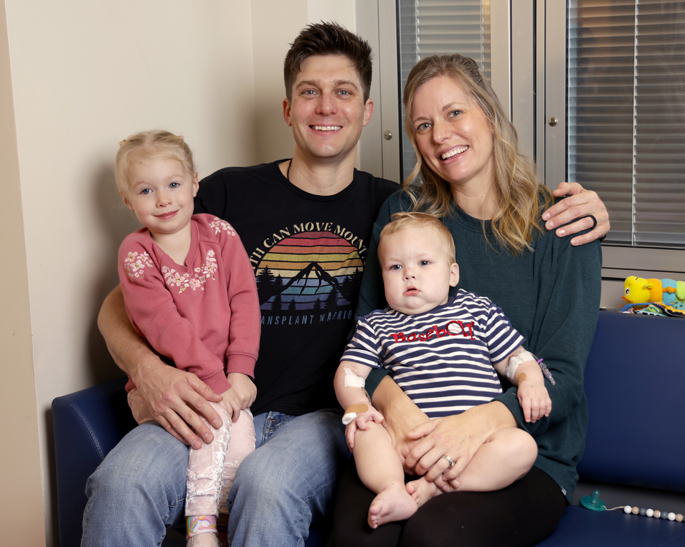
Krissy Campbell did what no other mother has done at Monroe Carell Jr. Children’s Hospital at Vanderbilt. She gave her 14-month-old son, Cameron, a portion of her liver.
The lifesaving surgery — a living donor liver transplant — was the first ever performed in a pediatric patient at Monroe Carell.
In 2022, at two days old, Cameron became critically ill.
Seemingly born healthy, he became lethargic, developed labored breathing, and had a low body temperature. The drastic change sent the family to their local emergency room.
After hours of testing, Cameron’s condition continued to worsen.
“He was literally dying,” recalled Campbell. “Although rare to do, they checked his ammonia levels. It came back very elevated. It was the clue they needed to know what was happening.”
Cameron, who lives in Roswell, Georgia, was transported to Children’s Healthcare of Atlanta and placed on dialysis to remove the toxic buildup of ammonia. Genetic testing showed he had a metabolic disease called ornithine transcarbamylase deficiency, a genetic disorder that prevents the breakdown and excretion of ammonia. It is in the family of urea cycle disorders. Untreated, the high amounts of ammonia can cause brain damage, coma and eventually death.
“It’s an incredibly rare disorder and mutation,” said his mother. “His dad and I were both tested, and we are not carriers. He is missing an enzyme and cannot process protein. The cure is a liver transplant.”
After waiting nearly 11 months on the liver transplant list, the Campbells came to Monroe Carell in the fall of 2023 once they learned that the hospital offered living donor liver transplantation as a surgical option.
The shortage of solid organs has long been an issue for those seeking lifesaving transplants. Typically, children under the age of 2 are most impacted by the low availability. Living donor liver transplantation has helped address this issue.
“Most people know that we have two kidneys and can live with just one,” said Saeed Mohammad, MD, MS, associate professor of Pediatrics and director of the Pediatric Solid Organ Transplant Center and Liver Transplantation at Monroe Carell. “What many don’t realize is that you can donate a portion of your liver and it will regenerate. You can literally save a life by donating a piece of your liver.
“We are the only program in the state doing living donor liver for pediatrics right now,” he said.
“What is unique about living donor liver donation is that it increases the pool of transplantable organs so a deceased donor liver can go to someone else. Any healthy adult can do it; it doesn’t have to be a family member. Our ability to offer this option will save many lives in our region and across the country,” said Mohammad.
The donated portion of the liver will grow in the recipient to meet the body’s needs, and the donor’s remaining liver grows back to nearly its normal size in a few weeks. Living donor recipients also typically have a faster recovery and better outcomes, added Mohammed.
There are not enough deceased donor livers available for adults and children. A donation from a living donor can significantly shorten the amount of time a recipient must wait to receive a transplant, which also allows a deceased donor liver to be available for someone else.
Joseph Magliocca, MD, director of the Vanderbilt Transplant Center and surgical director of the Pediatric Liver Transplant Program, performed Cameron’s transplant.
“Small children are a particular challenge to find an organ for given the significant size constraints and the need for an organ of the highest quality to give the greatest chance for normal long-term function,” said Magliocca, professor of Surgery in the Division of Hepatobiliary Surgery and Liver Transplantation within the Department of Surgery.
“Living donation fills this need perfectly,” he said. “It allows our patients to avoid long waiting times, to receive a perfect organ, and to increase the number of available organs for others on the waiting list.”
For Magliocca, cases such as Cameron’s are particularly rewarding, as he is now essentially cured of his disease and will be able to live a relatively normal, healthy life.
“I felt like it was always my purpose,” said Campbell. “We never found a match for him before coming to Monroe Carell. It was in my heart that it was always supposed to be me. I am a perfect match, and my liver is the right size.
“I feel so blessed to give this gift to my son. I just want Cameron to live a full life — he has not been able to do that. This is a second chance at life, and we just feel so blessed.”
Campbell, who was under the care of Michael Rizzari, MD, associate professor of Surgery and surgical director of Living Donor Liver Transplantation at the Vanderbilt Transplant Center, said her experiences at Vanderbilt University Medical Center and Monroe Carell have been outstanding.
She wants to help highlight living donor transplantation for others to take advantage of the option.
Discharged four days after her surgery, Campbell said both she and Cameron are doing very well.
“Cameron was discharged one week after surgery. We are staying in Nashville for four to five weeks to be close the hospital for follow ups and labs,” she said.
“Living liver donation is not available everywhere. I had no idea that it was an option. Cameron was the first at Monroe Carell, and I just want the program to continue to help children like him.”












